*This post was previously live on my other site TheWingedFork.
We were having a chat about the number of UNESCO sites in Asia that we’ve visited. And it seems my percentage of World Heritage Sites is really really small. So I asked my friends who have visited more places than me, ‘Which are some of the most amazing must-visit World Heritage Sites in Asia?’
And they gave me a list of the United Nations Educational Scientific and Cultural Organization (UNESCO) sites that they recommend visiting in Asia. They’ve told me a bit about the cultural and physical significance of these forests, lakes, deserts, monuments, and ruins that have world heritage status.
1. Joseon Dynasty tombs in Seoul, South Korea

Pic by Chris from Worthy Go
UNESCO recognized the 40 Joseon Dynasty tombs across 18 locations in 2009, and although they’re scattered around the province, a few are in Seoul proper. The more time you have to reach the more distant ones, the more rewarding the experience is.
I’ll mention Taereung specifically (pictured here), since it’s easy to reach via public transportation, and a great example of the style. Each site was chosen based on their natural features — usually protected by a hill and facing south towards water. A red, spiked gate was constructed to signify this was a sacred place being entered.
If you can, be there when the tomb opens at 9:00am for some of the best views of the day! Taereung holds the remains of Queen Munjeong, along with a Royal Tomb Museum, makes for a calm place to start the day.
By Chris from Worthy Go
See Chris’s amazing pics on Instagram at Worthy Go
2. St. Augustine Tower In Goa, India

Pic by Abby from Abby’s Hearth
Built by the Portuguese in the 15th century, the Churches and Convents of Goa were built by Catholic missionaries using Portuguese architecture. Located in Old Goa, the include the St. Catherine’s Chapel, Sé Cathedral, Church of Our Lady of the Rosary, Church and Convent of Francis of Assisi, the Basilica of Bom Jesus, the Church of Saint Cajetan including the seminary, and the ruins of the St. Augustine Tower.
St. Augustine’s Tower is one of four towers leftover from the church of Nossa Senhora de Graca (Our Lady of Grace) that once stood here. The Basilica of Bom Jesus holds the body of Goa’s patron saint, St. Francis Xavier who died in 1552.
Devotees from across the globe come to visit in December when the body is available for public viewing. Se Cathedral is now a museum showcasing the Portuguese rulers and history of Goa. The St. Catherine’s Chapel is oft used for wedding ceremonies because of its beauty. These famous Asian churches are quite close to each other and can all be visited in a day, but if you really want to take in the history and architecture, spread them out over 2 days at least. You can also spend your days visiting the off the beaten path sites in Goa.
By Abby from Abby’s Hearth
Follow Abby on YouTube at Abby’s Hearth
3. Shuri Castle in Naha, Okinawa Japan
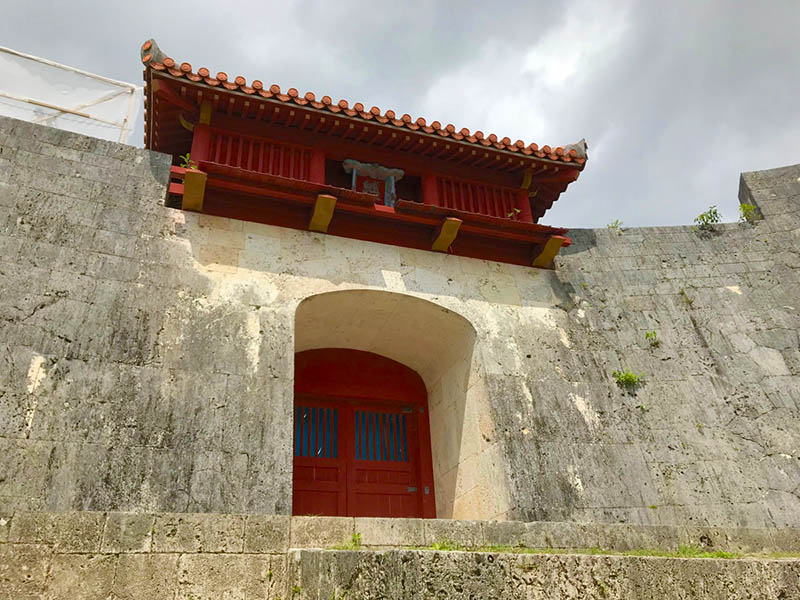
Pic by Michele from A Taste for Travel
The UNESCO World Heritage Site of Shuri Castle ( also known as Shurijo Castle) is a memorable historic site located in the port town of Naha on the island of Okinawa in southern Japan. Its strategic location in the Nansei-Shoto chain of islands meant it was ideally situated for controlling maritime trade through Asia in the 15th century, giving rise to the powerful Ryuku Kingdom.
The Ryuku monarchy governed from the 15th to the 19th century and the kingdom’s wealth can be seen in the impressive architecture and treasures replicated within the palace at Shuri Castle. Although destroyed during WWII the castle has been rebuilt with precision and much attention to detail. In modern times, visiting the historic site, its gallery of exhibits ( featuring the lavish royal throne) and recreated buildings is one of the top things to do in Naha, Japan.
For me, while the building itself is certainly impressive and quite different from other castles and palaces in Japan, the thing I enjoyed most about visiting the castle was exploring the surrounding neighbourhood. Ancient walking paths lead from Shuri Castle into the hills and meander past holy shrines, sacred wells and lookouts. It was there I was able to imagine what life may have been during the Ryuku era.
An annual festival celebrating the Ryuku culture with cuisine, music, dance and culture takes place at the end of October each year and is a prime time to visit.
By Michele from A Taste for Travel
See Michele’s amazing pics on Instagram at A Taste for Travel
4. George Town in Malaysia
If you like your UNESCO Heritage Sites in Asia served up with plenty of atmosphere, pretty colours and some of the best food on the planet then you will want to visit George Town, Penang.
George Town is the capital of the state of Penang in Malaysia and is located on the island of Penang. It’s the second largest city in Malaysia and it’s easy to get here with an international airport nearby and many buses from the rest of Malaysia.
However, it’s the central part of George Town which will interest you. It is UNESCO listed thanks to its culture, unique architecture and townscape. George Town was settled by the British in the 1700s and at that point became a melting pot of people and cultures as it still is today. The buildings are a mix of Asia and Europe and it’s fun to walk around the streets past the Chinese shop fronts, visiting the old fortress at Cornwallis Fortress and learning about history inside some of the historic homes.
This is not just an historic site, however. This city is very alive still today and also has become a popular destination to view street art.
If you like living history, come here!
By Sharon from Dive Into Malaysia
See Sharon’s amazing pics on Instagram at Dive Into Malaysia
5. Kathmandu Valley in Nepal
Several sites in the Kathmandu Valley were added to the UNESCO World Heritage List in 1979. The famous Durbar Squares in Bhaktapur, Patan, and Kathmandu are known for their Newari architecture that was built during the “Golden Age.” Each features intricate wood carvings, terracotta work, bronze sculptures, and pottery. You can also see the Swayambhunath and Boudhanath Stupas which are popular places of worship for Tibetan Buddhists. The lesser known places on the list are Changu Narayan and Pashupatinath Temple. They also happen to be my favorites.

Pic by Michelle from Full Time Explorer
Changu Narayan Temple is considered the oldest standing temple in Nepal. The actual date that it was built is unknown, but there is an inscription by King Manadeva from 464 AD. While the other UNESCO sites might see hundreds of tourists a day, this one might see ten. The temple is stationed on a hill which overlooks the valley. Close to the temple, you can find the Changu Museum and the Living Tradition Museum for an even better look at the history of the temple and surrounding areas.

Pic by Michelle from Full Time Explorer
Pashupatinath Temple is famous in Hindu culture as a cremation site. It sits on the Bagmati River which flows from the Himalayas. Mountains are considered holy by both Hindus and Buddhists, so the water that runs down from them is sacred. While witnessing a cremation may sound morbid, it’s actually extremely spiritual and enlightening. Many eastern religions believe in impermanence and watching a cremation is a reminder that we only have a short time on this earth. Watching one of the ceremonies take place is a wonderful way to get insight into Nepali culture and beliefs. I found the entire experience very moving.
By Michelle from Full Time Explorer
Follow Michelle on Facebook at Full Time Explorer
6. Sagarmatha National Park in Nepal

Pic by Michelle from Full Time Explorer
Sagarmatha National Park was added to the UNESCO World Heritage List in 1979. Sagarmatha is the Nepali name for Mount Everest and translates to “forehead in the sky.” Reaching Sagarmatha National Park is an adventure which involves either taking a jeep for days, flying into one of the most dangerous airports in the world, or trekking for over a week. It’s all worth it to see the tallest mountain in the world which stands at 8,848m. One of the most popular ways to see this National Park is to trek to Everest Base Camp. The trek takes between 12 to 18 days. Walking up to an altitude of 5,380m tests your mind and body, but in the end, the views are worth every step. While in the area you can see beautiful Tibetan Buddhist monasteries and learn about the unique Sherpa culture. Sagarmatha National Park is also known for being the home of endangered species like the snow leopard and the red panda.
By Michelle from Full Time Explorer
Follow Michelle on Twitter at Full Time Explorer
7. Chitwan National Park in Nepal

Pic By Michelle from Full Time Explorer
Chitwan National Park lies west of Kathmandu in the Terai region of Nepal. It was added to the UNESCO World Heritage List in 1984. Chitwan is the perfect place to go for nature and animal lovers. It’s one of the last sanctuaries for the greater one-horned rhinoceros and the Bengal tiger. It’s also a wonderful place to experience Tharu culture which is one of the 125 ethnic groups present in Nepal. A popular reason to visit the areas is for bird watching. Chitwan National Park is home to 350 different bird species. We visited in monsoon season when tigers make themselves scarce. Lucky for us, we were still able to see a myriad of exotic birds.
By Michelle from Full Time Explorer
See Michelle’s amazing pics on Instagram at Full Time Explorer
8. Polonnaruwa in Sri Lanka
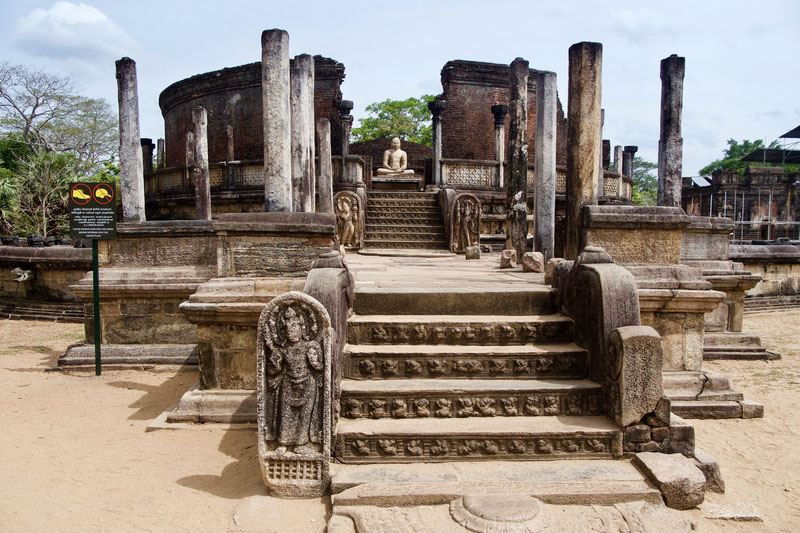
Pic by Erika from Erika’s Travels
The ancient city of Polonnaruwa is an unmissable highlight of Central Sri Lanka. Along with Kandy and Anuradhapura, Polonnaruwa comprises one of three main stops along Sri Lanka’s Cultural Triangle.
Founded by the Chola in the 10th century, the UNESCO site of Polonnaruwa contains some of the oldest historical relics in Sri Lanka. After the destruction of Anuradhapura in 993, Polonnaruwa became the center of the Sinhalese Kingdom in Sri Lanka and remained the island’s most important city for three centuries.
Scattered amongst verdant deciduous forest, the ruins of Polonnaruwa are home to reclining buddhas, temples adorned in frescoes and imposing pagodas. At the heart of the city lies the Sacred Quadrangle—Polonnaruwa’s most impressive site. The structure has some of the ancient city’s best preserved craftsmanship, including a raised stone platform with pillars and intricately carved bas reliefs. Four symmetrical staircase entrances lead to a central dagoba, which is home to seated Buddha statues.
Polonnaruwa’s well-preserved ruins offer a fascinating snapshot of Sri Lanka’s early architecture. The expansive ruins comprise one of the best preserved archeological sites in the country and are a testament to the historical influence and artistic prowess of the Chola and Sinhalese dynasties.
By Erika from Erikas Travels
See Erika’s amazing pics on Instagram at Erikas Travels
9. Jatiluwih Rice Terrace in Bali, Indonesia

Pic by Mo from Travelust 101
Jatiluwih Rice Terrace is a UNESCO World Heritage Site that represents an iconic Bali with vast, sculpted rice terraces with tall palm trees peppered throughout. While rice terraces can be found all over Bali from the famous Tegallalang to the remote highlands of Pupuan, what I loved about Jatiluwih Rice Terrace is the access to paved hiking trails through the UNESCO Site.
The trails make it easy to immerse yourself in the vast horizon of rice paddies without disturbing the farmers or falling through the cracks in the field! You can find three trails through Jatiluwih, with the shortest taking about 30 minutes, and the longest taking about 1.5 hours. Although Jatiluwih Rice Terrace attracts many tourists, it never feels overcrowded due to the enormous size of the property. When I visited Jatiluwih, I took the longest trail and ran into only a few other visitors during the entire hike.
The panoramic view of the rice fields at Jatiliwih is truly one of a kind. Be sure to put this one of your Bali itinerary!
By Mo from Travelust 101
See Mo’s amazing pics on Instagram at Travelust 101
10. Khajuraho Temple in Madhya Pradesh, India

Pic by Mariellen from Breathe Dream Go
For the past 13 years, I have travelled extensively across India and I’ve seen a lot of amazing temples, monuments, palaces, and forts. The country is a treasure trove of antiquity. But nothing prepared me for the beauty of Khajuraho. The Khajuraho Group of Monuments, as it’s listed with UNESCO, is a collection of Hindu and Jain temples dating from 1,000 years ago. Originally, there were about 85, but only about 20 are now standing. The finest temples are clustered together on well-maintained grounds within an area called the Western Group of Temples. You have to pay an entrance fee to see them.
The beauty of these temples is found in both the harmonious architecture and the incredibly intricate carvings and sculptures that adorn them. The largest, Kandariya Mahdeo Temple dedicated to the Hindu god Shiva, is considered one of the greatest masterpieces of Indian art. Several of the temples include artful carvings that depict everyday life, including sexuality, and these have become infamous for their bawdiness. But as my guide explained it, the temple carvings are not meant to be a three-dimensional version of the Kama Sutra – rather, these scenes represent the mundane world that we should rise above through spiritual aspiration.
The temples are the main reason people travel to Khajuraho, a small and sleepy town in a remote and not particularly easy to get to corner of Madhya Pradesh. But I’m very fond of it, I find it charming. And Panna Tiger Reserve is only about two hours away by car. Definitely worth it to make the trip, and take the time to get to know this part of India.
By Mariellen from Breathe Dream Go
See Mariellen’s amazing pic on Instagram at Breathe Dream Go

11. Anuradhapura temples in Sri Lanka

Pic by Claudia from My Adventures Across The World
Anuradhapura is one of the most beautiful temples in Sri Lanka, so unique that it has been recognized as a UNESCO World Heritage Site. It’s a massive site, and if you want to visit it thoroughly make sure to factor in at least 6 hours – though I shall warn you, it is so hot in Sri Lanka that after that you’ll be drenched in sweat and unwilling to continue.
Though the temples at Anuradhapura are very interesting, it’s the overall atmosphere that makes it worth visiting. On weekends and during prayer time you’ll encounter many locals, fully dressed in white (the color of prayer in Buddhism), who go to Anuradhapura to place their prayers in the various temples.
As this is a holy site, make sure to dress appropriately: wear loose fitting pants and a shirt that covers your shoulders. Make sure to remove shoes when entering the temples.
It costs around $25 USD to visit Anuradhapura, to which you’ll have to add the costs of a tuc tuc to take you around, or a bike rental.
By Claudia from My Adventures Across The World
See Claudia’s amazing pics on Instagram at My Adventures Across The World
12. The Cedars of God in Bcharre, Lebanon

Pic by Martin from Breaking Barriers
The cedar tree is prominent in the culture and history of Lebanon, taking centre place in the Lebanese flag, and being the national symbol of Lebanon. The cedar is mentioned numerous times in biblical texts. Unfortunately since those times the forests have been almost laid bare by human interference.
The last remaining stronghold of these great trees is located in Bcharre and is currently protected. Growing in the mountains, at an altitude of 2,000m they are a last remaining relic to the biblical times in Lebanon. Standing amongst them, you can almost imagine the Ancient Egyptians, Phoenicians, Babylonians, Romans, and other civilizations working in the forests getting the wood for their sea faring vessels.
In the winter the area is covered in a thick blanket of snow and is a stunning sight to behold. Walk in the forests and let your thoughts drift back to thousands of years ago to when the woods were alive with the bustling of human activity. Imagine the tales these trees could us of ancient races and peoples. And the sorrow they would feel from being depleted so much by their so called protectors.
By Martin from Breaking Barriers
Follow Martin on Facebook at Breaking Barriers
13. Tyre Necropolis in Tyre, Lebanon

Pic by Martin from Breaking Barriers
One of the most amazing things we like about history and ruins is the feeling of walking where someone did thousands of years ago. Seeing almost what they saw, knowing that our feet are touching the same ground theirs did.
Walking down the streets of the Tyre Necropolis in Lebanon gives this feeling. The ancient road leads to a triumphal arch, and to its side lies a great Roman Hippodrome. Built by the Ancient Romans, it was considered one of the top five racecourses in the Levant region.
The hippodrome is seen as one of the best preserved in the world. Due to this preservation you can almost imagine the sounds of the chariots and the thundering of the horse’s hoofs. The baying roars of the crowd as spills occur at the turning posts. With almost no other tourists around, the Tyre Necropolis really leaves you to your own thoughts and imagination.
(A word of advice before visiting, do some research on the area first as there is very little information about the ruins on the site itself).
By Martin from Breaking Barriers
See Martin’s amazing pics on Instagram at Breaking Barriers
14. Byblos in Lebanon
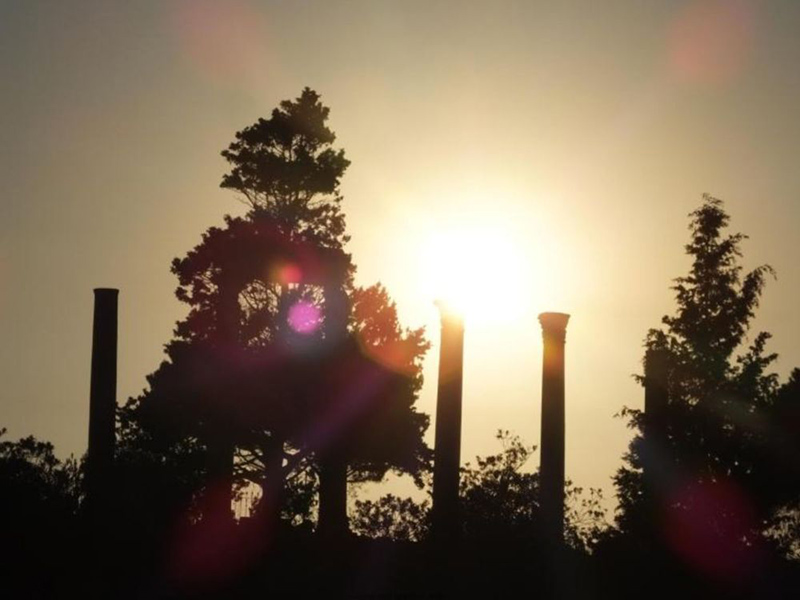
Pic by Martin from Breaking Barriers
Byblos, known locally as Jbeil, is one of the oldest continuously inhabited cities in the world, believed to have first been settled between 9000BC and 7000BC. Walking around the archaeological part of the town you can see prehistoric ruins, Roman ruins, Phoenician ruins, and Crusader ruins.
Inside the old Crusader castle on the site is a museum that shows some artifacts found on the site. It is rare to find an area where you can see artifacts from so many different civilizations in such a small place.
Sitting on the steps of the amphitheatre, watching the sun sinking into the Mediterranean Sea, with Roman columns standing defiantly since first erected close by, is both a beautiful and a haunting feeling.
Byblos is a true sign of the many civilizations that have occupied Lebanon throughout the ages, and it is also a sign of how this small Mediterranean country has been so important to the development of the world since civilization first started.
The town of Byblos itself is vibrant and lively and has some great little street bars to relax in after walking around the archaeological site
By Martin from Breaking Barriers
Follow Martin on Facebook at Breaking Barriers
15. Angkor Wat in Siem Reap, Cambodia

Pic by Naomi from Eat Love Explore
The famous temple complex named Angkor Wat is located in Siem Reap, Cambodia and annually draws millions of people to this small South East Asian country. It’s a remarkable structure built thousands of years ago in the early 12th century. It features three prominent towers and is surrounded by a beautiful moat where you can get those stunning sunrise reflection photos.
Before knowing anything about Cambodia, I knew I wanted to visit Angkor Wat because of the Tomb Raider Temple, Ta Prohm. It was really cool to walk through the grounds because many of the temples have been taken over and swallowed by the roots of the trees. It almost feels like you’ve stumbled into Jumanji – yes, another movie reference, but it’s true!
In addition to the famous Angkor Wat and Ta Prohm, Bayon in Angkor Thom is a must-see and is known for its 54 towers that have 216 gigantic smiling faces.
I loved exploring Angkor Wat and learning about the history of these ancient temples. I felt transported through time and learned so much during my guided tour. The temples are also extremely photogenic, so bring an empty memory card and be ready to take lots of photos!
You can get 1-day tickets to Angkor Wat for $37 USD, 3-day tickets for $62 and 7-day tickets for $72.
Unless you really love history and temples, I think that the one-day pass is sufficient. If you really want to visit all of the temples on the site, then opt for the 3-day pass.
Angkor Wat is one of those places that definitely lives up to the hype. It definitely deserves a spot on your bucket list!
By Naomi from Eat Love Explore
See Naomi’s amazing pics on Instagram at Eat Love Explore
16. Chinese Garden in Suzhou, Shanghai China

Pic by Talek from Travels with Talek
Suzhou is town of almost 5 million inhabitants on the Yangtze River Delta in Jiangsu Province, one of China’s most prosperous areas. It is about 100 km south of Shanghai, a great day trip.
Suzhou is especially famous for two things; its textile manufacturing, especially silk, and its magnificent gardens.
The elegant and beautiful gardens of Suzhou exemplify the high achievement of classical garden development over a period of about 1000 years and have been designated UNESCO World Heritage sites. The artistic objective of the gardens is to imitate natural features like stones, water and greenery and present them in an aesthetically pleasing manner. Man-made structures can also be added to the garden composition such as pagodas and arched bridges. The end effect is stunning.
Most of these gardens were created by scholars, a fact that is reflected in the gardens’ names like “Garden of the humble administrator.”
Today there are about 69 such gardens in Suzhou most of which can be visited.
By Talek from Travels with Talek
Follow Talek on Facebook at Travels with Talek
17. Trang An in Vietnam

Pic by Penny from Globe Trove
One of the most interesting places that I have been to in South East Asia was a UNESCO Heritage site in Vietnam called Trang An. Located near the city of Ninh Binh, this particular iconic spot is not man made. Well most of it isn’t. It consists of a series of waterways that surround limestone peaks. The only way to navigate through Trang An is via boat. The boat takes you through a series of caves. The caves interconnect with each other to form pathways and it is really interesting to note how well the people managing the boat know how to navigate through them despite the poor visibility in areas.
The tour does take a while and there is a lot to see both while on the boat as well as the stops you make on the way. A temple that can only be accessed by boat, steps to a view point, jars filled and stacked in the caves and much more is all part of the journey.
By Penny from Globe Trove
Follow Penny on Facebook at Globe Trove
18. Great Wall in China
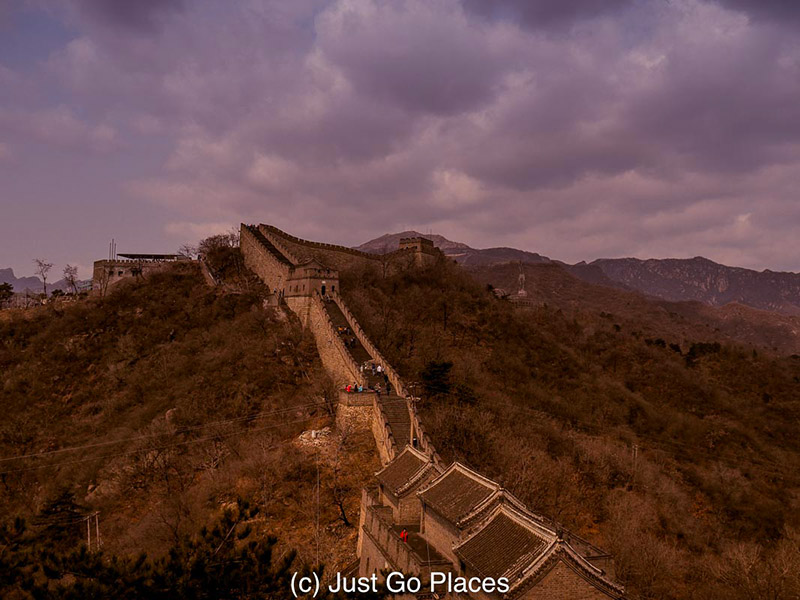
Pic by Shobha from Just Go Places
Although you hear how big the the Great Wall of China is, visiting it brings home the point what a tremendous man-made achievement it is. The Wall is about 13000 miles long and runs through 15 different regions of China! The Wall runs up and down hills and has little guard stations along the way. The scenery is spectacular whichever way you look. Being so old, not all places in the Wall are safe to visit and parts have been destroyed or eroded.
There are three places near Beijing where you can get onto the Wall itself (with the furthest section being the least touristed and about a 4 hour drive from the city itself). We chose to go to Mutianyu which was almost 3 hours away from Beijing. From Mutianyu where you can take a gondola ride onto the Wall and then take a toboggan ride down back to the visitor center.
By Shobha from Just Go Places
Follow Shobha on Facebook at Just Go Places
19. Hiroshima in Japan

Pic by Sylvia from Wapiti Travel
Hiroshima will remain related to the atomic attack for as long as it exists. The attack took place on August 6, 1945. A black day in history that has shaped the world that we currently live in.
The attack has been given a place in the history of the city and the hypocenter has been turned into a beautiful and serene peace park. The city does have other tourist sights as well but without a doubt a visit to the Hiroshima Peace Park is one of the main things to do in Hiroshima.
The peace park houses many monuments in memory of the thousands of victims but at the same time the monuments also call for a world at peace.
The most remarkable monument in the park is the A-bomb dome. It is the only building that miraculously survived the destructive power of the bomb although it was located only meters from where the bomb site. The original plans were to demolish the building but ultimately it was decided to preserve it as a memorial and since 1996 it is recognized as a World Heritage site.
Inside the park you also find the Peace Memorial Museum. The dramatic history of the city is very well documented in this Museum. We found our visit very educational and were touched by the many stories about how the survivors had to rebuild their lives and their town.
The park is centrally located in the city and is easily reachable with the tourist hop-on hop-off bus.
By Sylvia from Wapiti Travel
See Sylvia’s amazing pics on Instagram at Wapiti Travel
20. The My Son temple in Hoi An, Vietnam
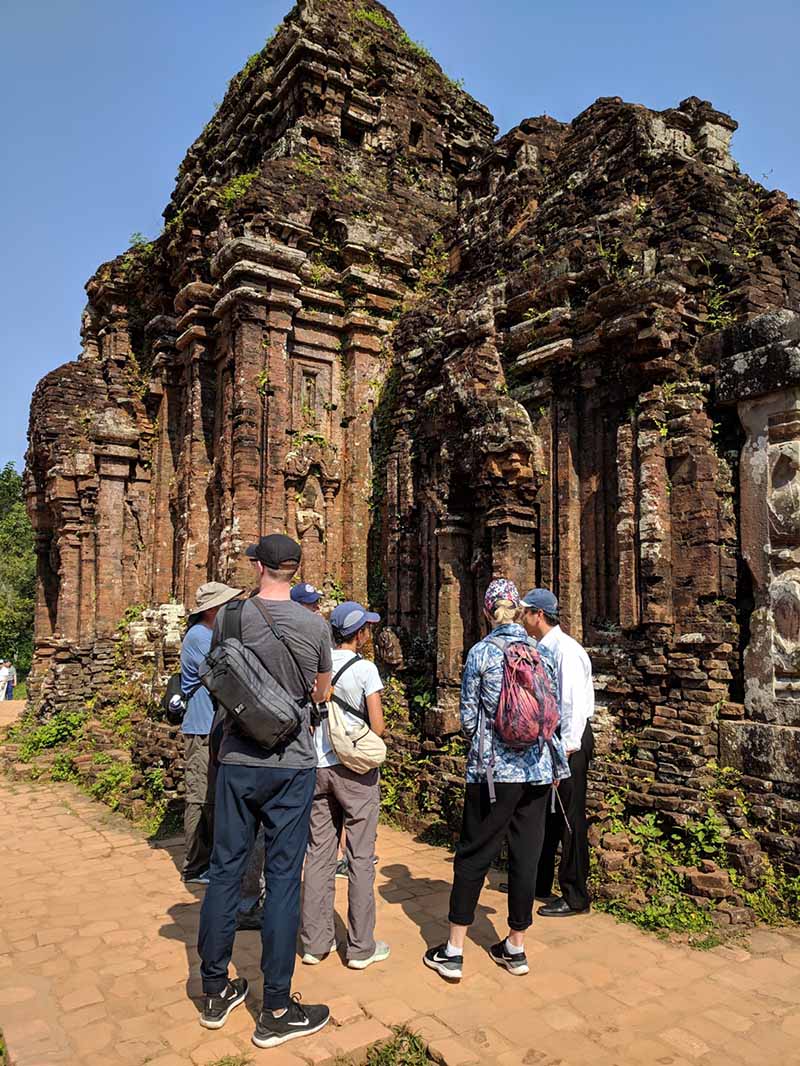
Pic by Michelle from Intentional Travelers
The My Son temple ruins are a UNESCO World Heritage site less than an hour away from Hoi An, Vietnam. The Hindu temples date from the 4th to the 13th centuries when the area was ruled by the Champa Kingdom.
There is a small museum with English translations inside the gates and then shuttles that drive you out a mile or so to the ruins. You can walk around and through the different temple plots within an hour. English-speaking guides are available on site for a small fee if you’re looking for more historical context.
Sadly, many of the temples were heavily affected by the Vietnam-American war, and you can even see craters from the places where bombs landed, but several areas have been preserved. What remains is small compared to more famous places like Angkor Wat, but you can certainly still get a sense for the significance of this ancient sanctuary and the mystery of what was lost.
By Michelle from Intentional Travelers
Follow Michelle on Facebook at Intentional Travelers
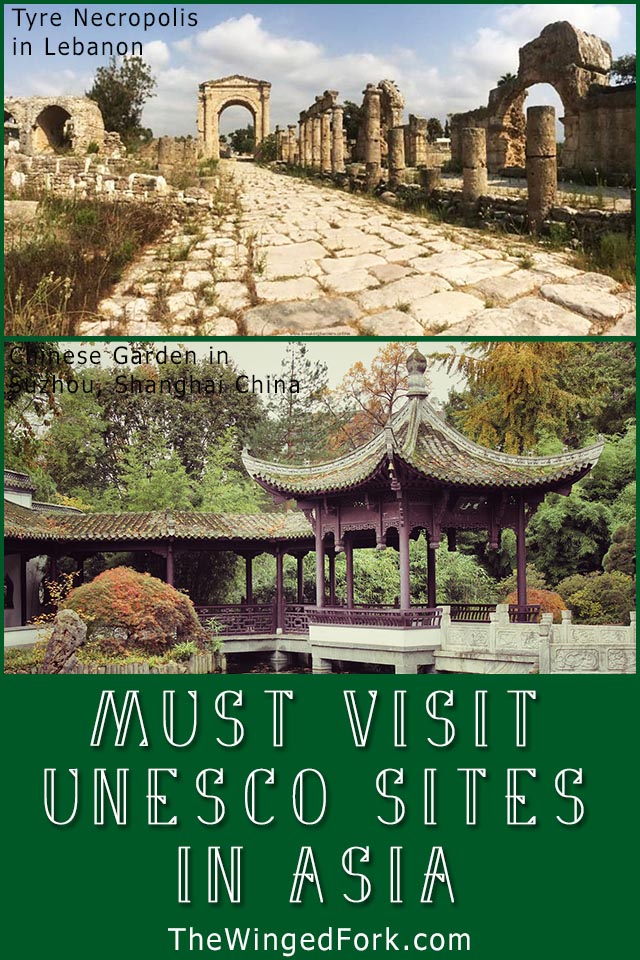
21. Kumbhalgarh Fort in Rajasthan, India

Pic by James from Travel Collecting
There are several hill forts in Rajasthan in the north of India, and together the hill forts of Rajasthan – Chittorgarh, Kumbhalgarh, Ranthambhore, Amber Fort, Gagron Fort and Jaisalmer Fort – are considered one of India’s many UNESCO heritage sites.
Chittorgarh is a huge rambling complex spread along the top of cliffs, with a lake / reservoir inside. Kumbhalgarh is fairly small, but has long crenelated walls that snake all over the surrounding hills. Ranthambhore is famous for the tiger sanctuary there, and the fort is on the site of former hunting grounds. Amber Fort in Jaipur glows golden in the soft light of early morning. You can easily spend hours exploring all of the rooms, including the harem where women were separated from public view. Jaisalmer Fort, the jewel of the Thar Desert, rises like something from a magic land straight out of the desert floor and can be seen from miles away. There are restaurants and hotels in the fort that have amazing views over the town and the desert beyond.
There are other hill forts in Rajasthan too, but a tour of these hill forts is a great way to discover the magic and history of this part of India. They are all very different from each other, so seeing and exploring them all gives a greater idea of the power and artistry of them all.
By James from Travel Collecting
Follow James on Pinterest at Travel Collecting
22. Toshogu Shrine in Nikko, Japan

Pic by Anne from Japan Travel Planning
We recently visited Toshogu Shrine in Nikko in Japan, which is a UNESCO Heritage Site with amazing history. Toshogu Shrine was built in 1617, to hold the remains of Tokugawa Ieyasu, who was the first shogun of the Tokugawa shogunate, with was the start of the golden Edo Period in Japan, and the basis of modern Japan today. After having visited many other shrines and temples in Japan, I can attest that Toshogu Shrine is the most lavish shrine that we visited and is well worth the journey. We really loved exploring the many shrine buildings, and popular features are the statues of the three wise monkeys and the sheer opulence of the whole site.
Nikko is located 2 hours north of Tokyo by train, and you can easily spend half to one day exploring the Nikko National Park, which contains Toshogu Shrine as well as the extensive Rinnoji Temple complex.
By Anne from Japan Travel Planning
Follow Anne on Facebook at Japan Travel Planning
23. The Tiger Leaping Gorge in China

Pic by Kenan and Brittany from Asia Undiscovered
When people think of hiking in Asia they often picture hiking in places like Thailand, Cambodia or Vietnam. But there is a special place in Mainland China that is just as unique and often times overlooked. That place is Tiger Leaping Gorge.
The Tiger Leaping Gorge is a scenic canyon and a UNESCO World Heritage site located on the Jinsha River in Yunnan province. It is the deepest gorge in China. Moreover, it has one of the deepest rivers in the world with a drop of 3,900 m (12,795 ft) from the mountain peak to the river bed. Another thing that makes this gorge special is that it is considered to be a ‘geological hotspot’ because of the various species of plants and animals living in the same area.
The History of The Name
The name ‘Tiger Leaping Gorge’ originated from an old Chinese story about a tiger and a hunter. According to the story, the hunter chased the tiger through the gorge until they reached the narrowest point. The tiger found itself trapped between the hunter and the rushing river at the base of the gorge. Left with no choice, the tiger lept the 25m (82 ft) gap across the gorge, escaping the hunter. Today, the rock from which the legendary tiger made its jump is an iconic viewing point.
My Experience Hiking The Gorge
I had the opportunity to hike the Tiger Leaping Gorge on a one-day hiking trip. This experience was the most physically demanding and rewarding experience I’ve ever had. The hike involved everything from stepping down steep, slippery steps and climbing several sets of rope ladders at the edge of a cliff. If you get the chance to visit China’s most famous gorge, you must plan a one day hike or walking tour there. It will be an experience you won’t forget.
By Kenan and Brittany from Asia Undiscovered
See Kenan and Brittany’s amazing pics on Instagram at Asia Undiscovered
24. Mt Fuji in Japan

Pic by Katie from The Accidental Australian
No trip to Japan would be complete without a visit to one of its most iconic landmarks- Mt Fuji. Mt Fuji is a mountainous volcano that sits near the popular onsen town of Hakone, located on the border of the Shizuoka and Yamanashi Prefectures.
Mt Fuji obtained UNESCO’s World Heritage status in 2013 and was recognized for its cultural and religious significance. Visiting Mt Fuji was one of the highlights of my time in Japan- although you can only climb in the warmer months, it is still incredibly spectacular viewed from land, by boat on Lake Ashi, or watch it zoom by as you speed through the country on a shinkansen, or Japanese bullet train. Mt Fuji also appears to be elusive, often dipping in and out of view from the clouds, or you may only see the tip of Fuji’s snow-capped peak before it reveals itself in full. Spending a few days in the Hakone region, easily accessible from Tokyo, is a great way to see the mountain, experience the onsen culture of the region, and enjoy hiking, delicious cuisine, and rich culture.
By Katie from The Accidental Australian
See Katie’s amazing pics on Instagram at The Accidental Australian
25. Temple of Preah Vihear in Cambodia

Pic by Soumya from Stories by Soumya
A lesser-known UNESCO heritage site in Cambodia, the Temple of Preah Vihear sits on a sharp cliff in the Dangrek mountain range on the Thailand-Cambodia border. The temple was involved in a long ownership struggle between the two countries until 2013 when it was finally awarded to Cambodia. Today, it is peaceful up here. You will see a few tourists and locals around. But there is a lot to explore.
The temple of Preah Vihear is unique because of its picturesque location on the mountains from where it commands a scenic view of both the countries. Additionally, the temple has a long north-south axial plan unlike the rectangular plan of most of its contemporaries. Architecture is exquisite and bears a number of traditional Khmer designs such as corbelled hallways, blind doors, and window colonettes. You have to walk through five Gopuras to reach the sanctuary where worship is still offered today.
Preah Vihear is a great destination if you are a lover of history and ancient Khmer architecture. It is fascinating to imagine what faith would have motivated people to construct such elaborate temples high up here. You can get to Preah Vihear by road from Siem Reap. The journey takes around 4 hours.
Make sure you carry a hat and lots of water. It can get pretty hot up here.
By Soumya from Stories by Soumya
Follow Soumya on Facebook at Stories by Soumya
26. Sambor Prei Kuk in Cambodia
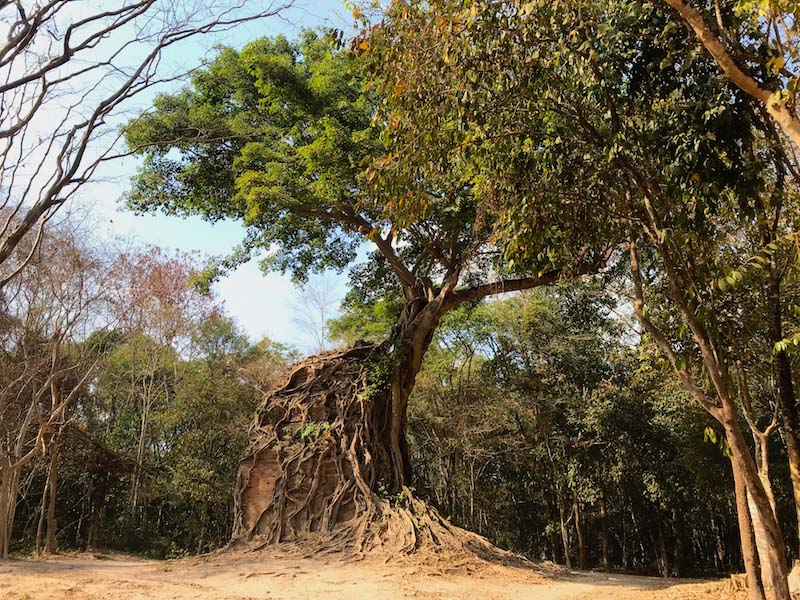
Pic by Sue from Travel for Life Now
During our trip to Phnom Penh, we had time to take a side trip to Sambor Prei Kuk, Cambodia’s third UNESCO World Heritage Site. Located halfway between Siem Reap and Phnom Penh, Sambor Prei Kuk pre-dates Angkor Wat. Built in the 7th century as the center of the Chenla Empire, the complex has about 50 temples. It is still in the early stages of restoration and many of the Hindu temples are still buried. The temple is surrounded by the forest, leading to its name which means “temple in the richness of the forest.”
Sambor Prei Kuk has very unique eight-sided temples. Don’t miss the lions at Lion Temple. There are only 2 lions still remaining at the temple. There is a wonderful temple with a tree growing in and around it at the entrance way that is even more stunning than Angkor Thom in Siem Reap.
Only recently designated a UNESCO World Heritage Site, Sambor Prei Kuk is still relatively undiscovered. When we visited, there were only a handful of people on the site. We wandered through the trees and saw the temples mainly by ourselves.
By Sue from Travel for Life Now
See Sue’s amazing pics on Instagram at Travel for Life Now
27. Petra in Jordan

Pic by Bret & Mary from Blue Ridge Mountains Travel Guide
Once described by poet John William Burgon as a “rose-red city half as old as time” and initially made famous by a key scene in Indiana Jones & the Last Crusade, the Jordanian city of Petra is an ancient archaeological wonder that remained hidden for centuries until Swiss explorer Johan Ludwig Burckhardt found it in 1812. Established around 300 BC as the capital city of the Nabataeans, Petra was the center of the region’s caravan trade because it allowed them to control the region’s water supply via a variety of dams, cisterns, and water conduits. They used their wealth from selling this water to construct amazing monuments and tombs that mix Greek and Egyptian influence. Get there early in the morning if you want to avoid the worst of the tourist crowds, and be prepared to deal with Bedouin touts hawking all manner of souvenirs. Whatever you do, make sure you plan enough time to climb the 500-step secret trail that takes you to a stunning viewpoint overlooking the famous Treasury (a.k.a. Al Khazneh).
By Bret & Mary from Blue Ridge Mountains Travel Guide
Follow Bret and Mary on Facebook at Blue Ridge Mountains Travel Guide
28. Humayun’s Tomb Delhi, India
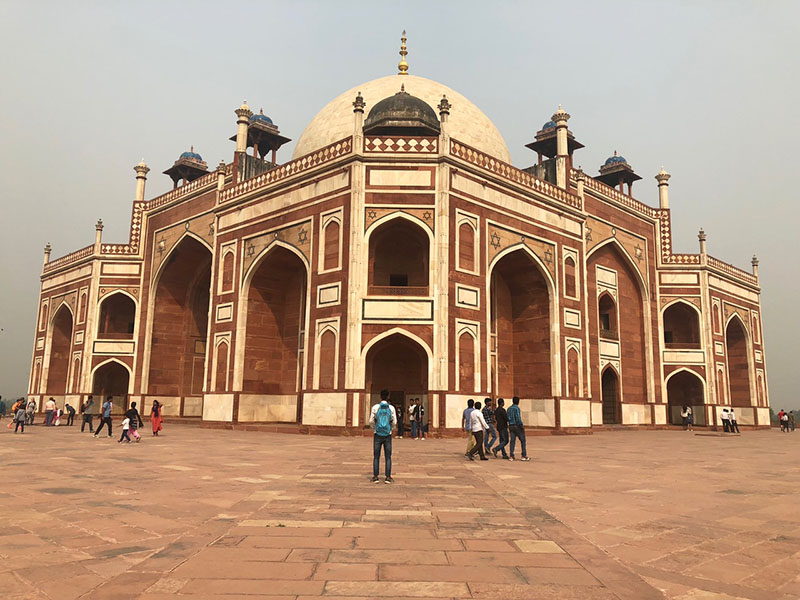
Pic by Maria from India Up Close
Known as the model for the Taj Mahal, Humayun’s Tomb in Delhi is an incredible UNESCO Heritage site to visit. It is one of the earliest examples of Persian influence on Indian architecture and its size and symmetry is simply stunning. The intricate details of the white marble and red sandstone structure are marvelous and extremely photogenic.
The mausoleum was built between 1565-1572 A.D. by Hamida Banu Begum, the grieving widow of Emperor Humayun. The Mughal emperor ruled over what is today known as Northern India, Pakistan, Afghanistan, and Bangladesh – an empire stretching over 1 million square miles.
Located in East Delhi, Humayun’s Tomb is a must-see for any tourist in Delhi. I loved the red sandstone and white marble tomb and took so many photos, but what made this place really special for me were the beautiful gardens surrounding it. it is refreshing to wander around the lush gardens. It is quiet and you can hear birds chirping, see monkeys playing and enjoy a cool breeze in the shade. It made me almost forget that I was in a city of close to 20 million people.
By Maria from India Up Close
See Maria’s amazing pics on Instagram at India Up Close
29. Prambanan Temple in Java, Indonesia

Pic by Julie from Insatiable Travel
Prambanan Temple Complex outside Yogyakarta, Java, Indonesia shocked me with its immense expanse, beauty, and the vast number of ruins. There is something about this complex that captivated me then left me curious. It has withstood the test of time while proving that different religions can live together in harmony.
Prambanan is the largest Hindu relic in Indonesia and many people have labeled it as the most beautiful temple in Southeast Asia. The beauty of the finely carved stone walls and majestic sculpted structures scattered around the grounds are a testimony to its glory.
Within the complex, there are three other temples, all of which are Buddhist, proving its religious tolerance of different beliefs. As I walked through the grounds I could feel the energy, history, and conflicts of the past. The complex is well manicured and has paved paths to each of the temples with signs to guide your way. There is a calm and peacefulness to the surrounding pastures and fields.
The complex is also home to the Ramayana ballet. Which tells an old traditional love story with the gorgeous illuminated temple as the backdrop at night under an open-air theater. An experience that is rich in culture, music, and color. Before the show, for a truly authentic meal, you can dine at one of the two restaurants on site.
I loved this complex because of the way I felt when I left. It left me feeling calm, inquisitive and inspired. The ornate details of art and ancient storytelling will stay with me forever. It’s a place that will touch your soul and mesmerize your mind making it a must-see UNESCO world heritage site.
By Julie from Insatiable Travel
See Julie’s amazing pics on Instagram at Insatiable Travel
30. Temple of Sacred Tooth in Kandy Srilanka

Pic by Delphine from Lester Lost
Lanka is a small country with no less than eight UNESCO World Heritage sites. As the former imperial capital of Sri Lanka, Kandy is one of them and should be on every travel bucket list. Kandy is rich in culture and historical landmarks, and you can easily spend several days exploring the area. The main reason for visiting Kandy is the Temple of Sacred Tooth. Built around a shrine containing a tooth of Buddha, the Temple is a complex ensemble of royal halls and places of worship. Sri Lanka is a mostly Buddhist country and the temple is always busy with pilgrims, which makes it a very lively place to experience.
Aside from the Temple of the Sacred Tooth, Kandy offers a variety of other places to visit, all worth seeing if you are interesting in Sri Lankan culture: don’t miss the Peradeniya Royal Botanical Gardens and the Geragama Tea Factory. If you have enough time, you can also add a visit to a spice garden and a batik workshop.
By Delphine from Lester Lost
See Delphine’s amazing pics on Instagram at Lester Lost
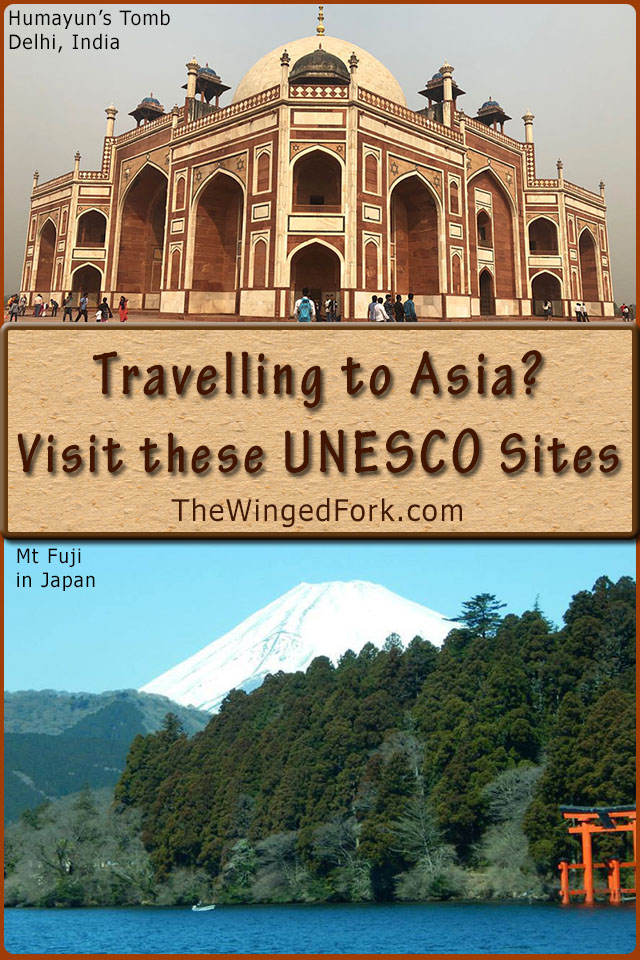
31. Taj Mahal, Agra, India

Pic by Joel from World Heritage Journey
The incredible Taj Mahal is one of the world’s most famous UNESCO World Heritage sites. Built in the 1640s by the Mughal emperor Shah Jahan, it’s a mausoleum that houses the tomb of his favourite wife, Mumtaz. Constructed of gleaming white marble, the Taj stands alone on the banks of the Yamuna river in Agra, surrounded by formal gardens. Also nearby in the complex is a large mosque and a guest house too.
Although the Taj is undoubtedly impressive in its size, grandeur and symmetry (the only non-symmetrical thing in the entire complex is Shah Jahan’s tomb, which was added later), my favourite part is definitely the intricate detailing found everywhere on the building. It’s not as apparent on distance photos, but all of the facades are covered in Islamic calligraphy, floral and geometric carved patterns, and semi-precious stones too. It’s absolutely incredible.
A couple of tips for visiting: although the sunrise is said to be one of the best times to see the Taj, with the changing colours reflecting off the white marble, make sure you check the weather before you go! Agra is renowned for heavy fogs, particularly in the winter months, so your sunrise view might be of nothing but a dense cloud bank! Avoid lines and potential scammers by buying your tickets online directly from the Archaeological Survey of India (https://asi.payumoney.com). And make sure you pay a little extra for the mausoleum interior access, it’s well worth it!
By Joel from World Heritage Journey
Follow Joel on YouTube at World Heritage Journey
32. Kiyomizu-dera Temple “Pure Water Temple” in Kyoto, Japan
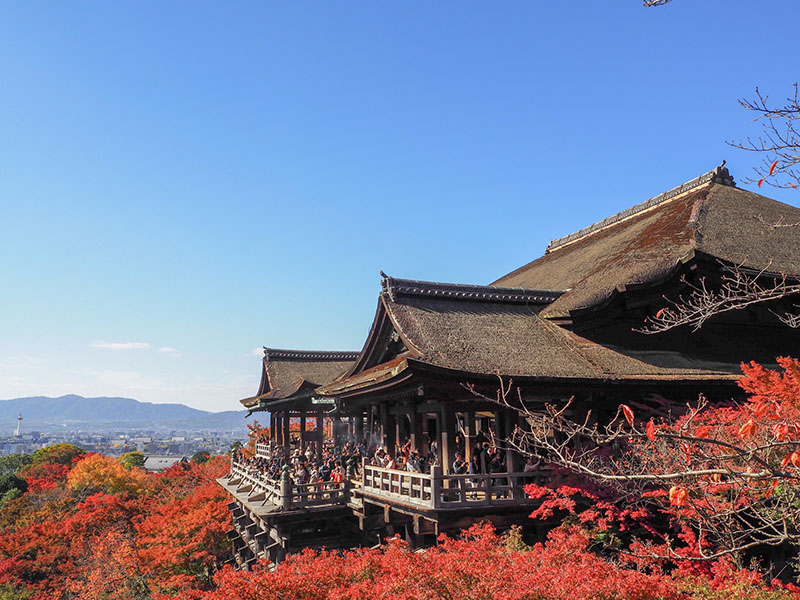
Pic by Mariza from Hop on World
Kyoto is a city that seems to have it all – colorful temples, beautiful gardens, age-old traditions and a rich history. Not to mention culinary feasts around every corner. Simply put, there is no shortage of tops sights to explore in Kyoto! But any visit to Japan’s Ancient City would simply not be complete without stepping into Kiyomizu-dera; a centuries-old temple neatly nestled on the hills of Mt. Otowa, just east of the city.
With its rich history dating back to 778, the temple plays an important role in the heritage of Japanese culture till this day. And not surprisingly, is part of the Historic Monuments of Ancient Kyoto and a UNESCO World Heritage Site.
Kiyomizu-dera offers a unique glimpse into age-old traditions fused with colorful temple buildings and sublime gardens offering ever-changing landscapes each season. The temple might be best known for its wooden stage and main hall, which does not hold a single nail. But apart from its magnificent construction, it’s also one of the best spots to enjoy breathtaking views of the temple grounds and the city from afar.
Once you’ve explored the various temples, shrines and the pagoda, don’t forget to drop by the Otowa Waterfall (located at the foot of the main hall). Here you’ll find three separate streams of water. Each stream is believed to bring luck in the form of longevity, good grades and love. (But just a tip though – choose wisely! Drinking from all three streams is heavily frowned upon).
Seeing that the temple is one of the most recognised temples in Japan, it’s best to time your visit here. Come in the early mornings or late afternoons to skip the crowds. The grounds open at 6:00 daily and usually close at 18:00 depending on the season. There is also a ¥400 entrance fee to visit here, but it will undoubtedly be money well spent
By Mariza from Hop on World
See Mariza’s amazing pics on Instagram at Hop on World
33. Group of Monuments at Hampi in India
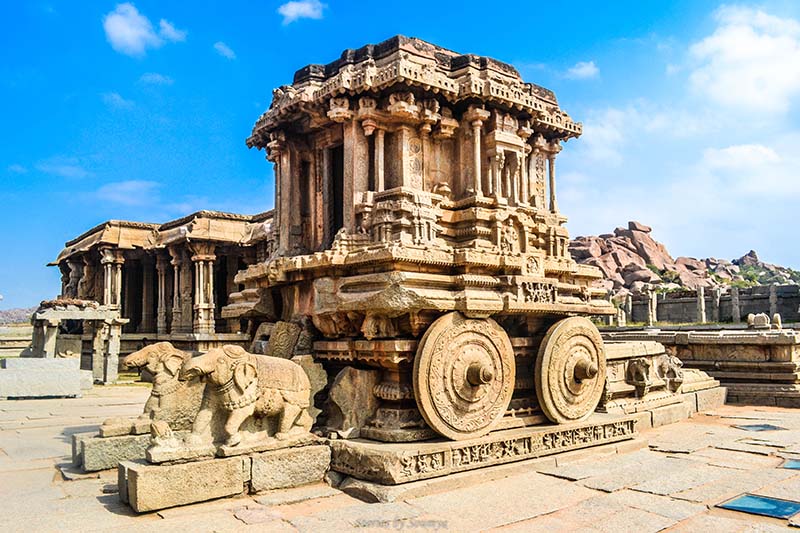
Pic by Soumya from Stories by Soumya
Hampi, an ancient village in southern India, is home to some of the most fascinating temples, monolithic statues, and royal pavilions from the 14th century. These structures together form the Hampi Group of Monuments that was accorded the UNESCO heritage status in 1986.
The prosperous city of Hampi functioned as the capital of the India’s Vijayanagara Empire for a very long time. It was during this period that most of these grand temples and complexes were built.
The most iconic among these is the Vijaya Vittala temple with its stone chariot and musical pillars. Also notable is the Virupaksha temple right across the Hampi bazaar. Look out for some exotic frescoes on the temple walls and ceilings.
Today, Hampi’s boulder-strewn landscape is peppered all over with ruins of sacred shrines, pillared mandapas, water reservoirs, and royal complexes. Taking a tour of Hampi is like walking through an open museum and imagining life from 800 years ago.
You can get to Hampi from Bangalore by rail or road. The best time to visit is during the winter months of November – February. Summers can get pretty hot and humid.
By Soumya from Stories by Soumya
Follow Soumya on Pinterest at Stories by Soumya
34. A-Ma temple and ruins of St. Paul in the Historic Centre of Macau

Pic by Wendy from Empty Nesters Hit the Road
At first sight, Macau seems to be all about the large, glitzy casinos and their high rise hotels. But in the heart of this island is the charming Old Macau with its dual Chinese and Portuguese influences. For four hundred years China leased this land to the Portuguese. Today control has returned to the Chinese, but there are plenty of opportunities to experience the unique architecture and food of this former colony.
One of the highlights of Old Macau is the Ruins of St. Paul, a single exterior wall that has been reinforced to show visitor’s where the entrance to this 17th-century Asian church once stood. Today, after taking pictures and passing through the doorway, visitor’s can explore the small museum housed in the church’s former crypt.
A-Ma Temple is another must see in Old Macau, a 15th century Chinese temple built into the side of a cliff that requires climbing several staircases to explore all the small shrines.
In between the exploration of historic sights, visitors should also sample traditional foods of Old Macau like Portuguese egg tarts, pork chop buns, and meat pies.
Finally, to get excellent views of both old and new Macau, head uphill to Monte Forte, the fortress built to protect Jesuit properties. Take a break in the shade of the large trees, explore the 32 cannons, and appreciate all that Macau has to offer.
By Wendy from Empty Nesters Hit the Road
Follow Wendy on Facebook at Empty Nesters Hit the Road
35. Singapore Botanical Garden in Singapore

Pic by Matilda from The Travel Sisters
The beautiful and large Singapore Botanic Gardens are Singapore’s first and only UNESCO World Heritage Site and a must on your Singapore visit. The Singapore Botanic Gardens are the first gardens in Asia to make the list as well as the first and only tropical botanic garden.
The gardens evolved from a British tropical colonial botanic garden to a scientific institution used for education and conservation and a leading centre for horticultural and botanical research. In addition to admiring the beautiful plants and flowers, there is a lot to explore as the Singapore Botanic Gardens has several small gardens and trails, a children’s garden, lakes, a small tropical rainforest and the National Orchid Garden which has the largest display of orchids in the world.
These gardens are massive and the perfect thing to do in Singapore for every visitor from couples enjoying a romantic stroll to families. The Singapore Botanic Gardens are free to visit (except for the National Orchid Garden which charges a small entrance fee).
By Matilda from The Travel Sisters
Follow Matilda on Facebook at The Travel Sisters
36. Jeju in South Korea
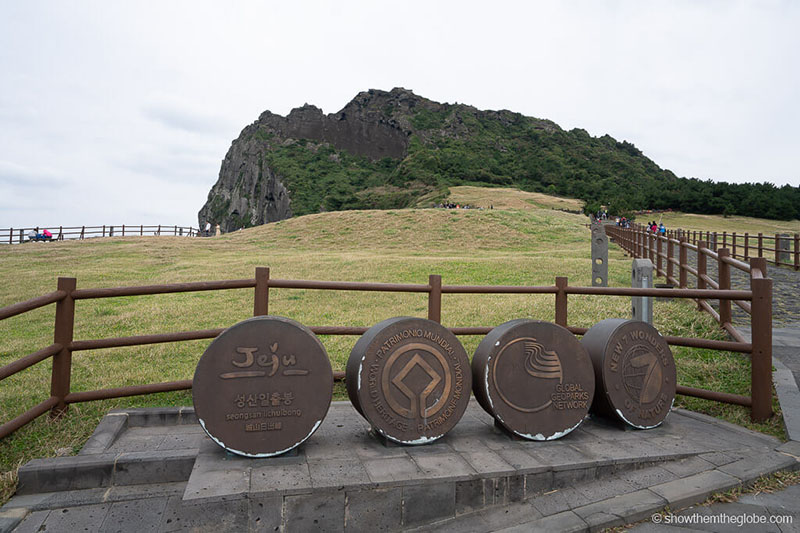
Pic by Elaine & David from Show Them The Globe
South Korea’s Jeju Island is one of the most beautiful UNESCO World Heritage Sites in Asia. Listed as Jeju Volcanic Island and Lava Tubes, it is comprised of three sites: Seongsan Ilchulbong, Mount Hallasan and the Manjanggul Lava tubes. As well as being part of the Jeju UNESCO listing, they are also among the most popular tourist attractions in Jeju.
Mount Hallasan, is a Jeju icon. It is the tallest mountain in South Korea and is visible from all over the island. The highlight is the stunning crater lake filled with turquoise waters which is visible after hiking to the peak.
Seongsan Illchulbong is a 5,000-year-old volcanic cone-shaped crater topped with 99 jagged rocks resembling a crown. Known as Sunrise Peak, it is famous for its incredible sunrise views and is one of the new 7 Wonders of the World. Hiking Seongsan Illchulbong is a highlight and one of our favourite things to do in Jeju with kids.
The final sight making up the Jeju UNESCO is the Manjanggul Lava tubes, one of the most impressive lava tunnels in the world. Visitors have access to 1km of the caves and we loved meandering among stalactites and lava toes. There’s even a lava stone which resembles the shape of Jeju Island as well as the largest lava column in the world.
By Elaine & David from Show Them The Globe
37. Sigiriya Rock in Sri Lanka

Pic by Daniel from Destinationless Travel
The ancient city of Sigiriya is one of the oldest in Sri Lanka. Although a large city, the main attraction is the palace built upon the 200m high Sigiriya Rock (also known as Lion Rock.) It is said to be the “impossible palace” due to its location and because of this, UNESCO has declared it as the 8th Wonder of the World. The city that surrounds the palace is also one of the best remaining examples of ancient urban planning.
A visit to Sigiriya was a very special moment and one of the best I enjoyed in Sri Lanka. Not only are the ruins well preserved, but in some parts they have been restored to their former glory. As the UNESCO 8th Wonder of the World you simply can’t miss the opportunity to gaze upon another ancient city that has archeologists scratching their heads at this architectural feat accomplished so long ago.
By Daniel from Destinationless Travel
Follow Daniel on Facebook at Destinationless Travel
38. Gunung Leuser National Park – the tropical rainforest heritage of Sumatra, Indonesia

Pic by Gábor from Surfing the Planet
Sumatra is the most Western of the big islands of Indonesia. It’s a much less popular destination than Bali, Java or other islands. Nevertheless, Sumatra is one of the most authentic places to visit in Indonesia, and it contains one of the most spectacular natural heritages of Southeast Asia. More than 2 million hectares are occupied by tropical rainforests with an amazing biodiversity, not found in anywhere in the archipelago of Indonesia.
Amongst the tropical rainforests, the Gunung Leuser National Park is the most accessible and interesting for travelers, since it’s the natural habitat of the Sumatran orangutans. A lot of effort has been made to conserve the habitat of this endangered species. It’s an amazing experience to do a jungle trek looking for these fascinating creatures that live in the Sumatran rainforest. The usual base to visit the area is the small village of Bukit Lawang
By Gábor from Surfing the Planet
Follow Gábor on Facebook at Surfing the Planet
39. Sun Temple in Konark, Orissa, India

Pic by Shivani from The Wandering Core
Devoted to the God of Sun, the opulent Sun Temple in Konark will bewitch any architecture fanatic. Rumored to be built in the 13th century by Narsimhadeva I in the shape of a chariot. Fascinatingly, the temple doesn’t host any Hindu shrine making it unique and far from religious tourism. The main shrine where deity figure was placed historically is closed for tourists however the rest of the temple is open. As a chariot, the temple is devised on 24 gigantic intricately carved wheels, which also denote the current time of the day based on shadows hey cast. The chariot is metamorphically drawn by 7 horses which are ultimately pulling these wheels. There are two lion figures on the entrance which are killing the elephants symbolizing the protection to the temple.
Witnessing the architecture of the temple first hand was an exquisite experience for me. A history lesson combined with a panorama of marvelous Hindu architecture sums up my visit to the Sun Temple. I suggest visiting the temple in the early hours of the day to dodge the crowds & capture the pleasing dawning of the day in your camera.
By Shivani from The Wandering Core
See Shivani’s amazing pics on Instagram at The Wandering Core
40. Ha Long Bay in Vietnam

Pic by Arrianne from Travel Habeat
Ha Long Bay literally means “descending dragon”. Located in the province of Quang Ninh in Northern Vietnam, it was declared as a UNESCO World Heritage Site in 1994. Ha Long Bay has that picturesque seascape adorned by over a thousand limestone karsts and islets. No doubt it is one of the must-see places when traveling to Vietnam.
Apart from the visual feast, what I like the most about this destination is that you can explore it by means of a relaxing cruise. And what made the so-called Ha Long Bay cruise more interesting is that you will board a traditional, wooden boat. How cool is that? A full-day cruise would be enough for you to relish its remarkable beauty.
You can also unravel at least one of Ha Long Bay’s limestone caves and grottoes like Thien Cung, Dau Go, and Sung Sot. The enchanting caves not only showcase astonishing stalactites and stalagmites, they are well maintained and decorated with natural and artificial lights. I’d say cruising Ha Long Bay is a delightful breather from the busy streets of Vietnam. Don’t ever miss it!
By Arrianne from Travel Habeat
Follow Arrianne on Facebook at Travel Habeat
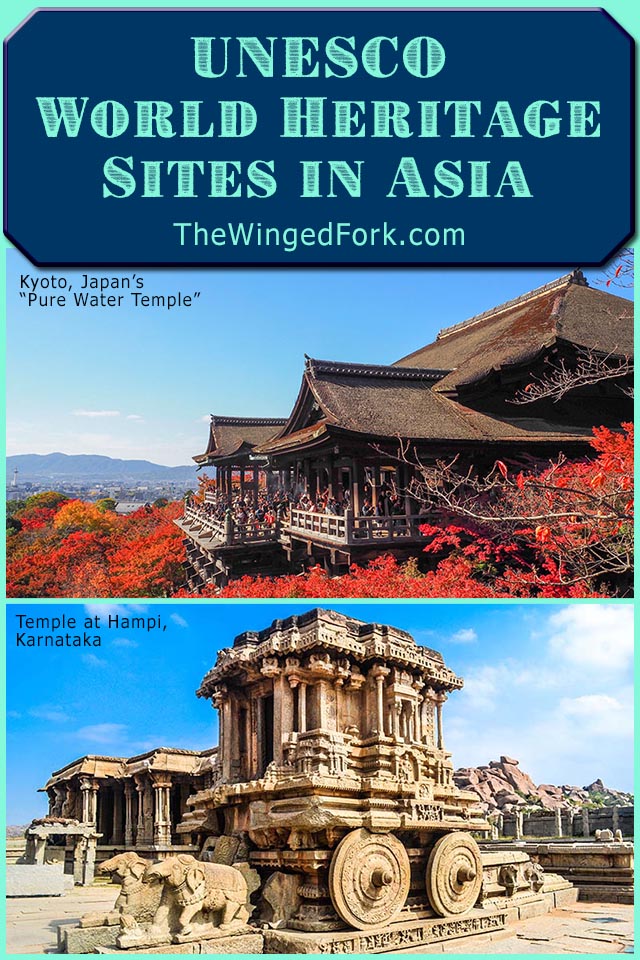
41. Ellora Caves in Maharastra, India

Pic by Kimaya from Homosapien Intransit
Ellora caves are located in the state of Maharashtra, India. These are ancient caves with temples having engraved drawings which are beautifully and precisely carved out ancient rocks. There are around 34 caves accessible to the public which are mostly based on Hindu, Buddhist and Jain ideologies. You need to spare a full day to visit all these caves and get immersed in the beautiful ancient era which is over a thousand years old.
The Kailasa Temple which is in cave 16 is three stories high and is carved out of a single rock making it the largest monolithic rock-cut temple in the world. All these magnificent rock structures speak for the noteworthy achievements of structural engineering and craftsmanship. To reach Ellora, Aurangabad City has the closest airport which is 40 km (25 miles) from Ellora and also a railway station.
When I visited Ellora, it was a part of our Aurangabad City tour and I wanted to stay back for more time because these caves are historic and beautiful to look at. The carvings of various deities like many poses of Lord Shiva and Lord Buddha from the different mythologies depicts the harmony prevalent in that era.
By Kimaya from Homosapien Intransit
Follow Kimaya on Pinterest at Homosapien Intransit
42. Luang Prabang in Laos

Pic by Ania from The Travelling Twins
Luang Prabang sits in northern Laos at the confluence of the Nam Khan and Mekong rivers. It’s a fabulous site surrounded by jungle and mountains, and the town itself adds even more richness. The French established modern Luang Prabang in the late nineteenth century as their local capital. The result is a chic and sophisticated city nestling in the wild rainforest.
As mentioned in the UNESCO listing, the city’s remarkably well-preserved townscape reflects the alliance of the two distinct cultural traditions, Buddhism and French Colonial architecture. It’s wonderful to spend a week here soaking up its historical atmosphere and participating in its timeless culture.
We particularly enjoyed learning about rice cultivation and silk manufacture in places where we could learn by experience. Then we also immersed ourselves in activities which are very specific to this place. These included the early morning Alms ceremony and catching a magnificent birds-eye view of the city and jungle from the sacred Mount Phousi.
There is lots of thing to do in Luang Prabang. Try zip-lining in the jungle canopy between the highest treehouses in Asia or swimming in the pools of the fabulous Kuang Si waterfalls.
By Ania from The Travelling Twins
Follow Ania’s husband James on Instagram at Nick James Illustrator
43. Elephanta Caves in India

Pic by Sarah from The Winged Fork/Abby’s Hearth
The Elephanta Caves that are located on The Island of Elephanta in Mumbai Harbour, Maharashtra, India are cave temples that are dedicated to the Hindu god Shiva. The island was originally called Gharapuri which got its name from a massive stone image of an Elephant that is now displayed at Veermata Jijabai Bhonsle Udyan, the erstwhile Victoria Gardens in Byculla, Mumbai.
The cave complex was inscribed by UNESCO as a world heritage site in 1987. The cave complex comprises of 7 caves, that date back from the 5th to 7th century, however, cave no.1 has more statues of Shiva and many intricate carvings and designs, the other caves are plain and less carved.
In order to get to the caves you have to take a ferry across from the Gateway of India at Colaba to Elephanta Island, the journey takes about an hour. Make sure you are wearing comfortable walking shoes, a hat and also carry some water or energy bars as there are plenty of steps to walk up to the main cave complex.
You could take the toy train for the first few kilometres. There are quite a few food stalls and handicrafts stalls on either side that you can buy from along the way. But, beware of monkeys as they tend to snatch away water bottles or food that you carry along.
By Sarah from Abby’s Hearth
Follow us on Pinterest at AbbysHearth
44. Gunung Mulu National Park in Malaysia

Pic by Ania from The Travelling Twins
Our trip to Mulu became one big adventure from the moment we got to Kuching airport. We would be flying in such a small aeroplane that not only was our baggage weighed, but we were too.
It was fun flying in this tiny aircraft. Just ten seats and we could look over the pilot’s shoulder to see through the front windscreen. Mulu is right in the heart of the Borneo rainforest. There is no other way to get there other than by air, and as we approached it, the views became more spectacular. This almost untouched jungle and cave system was to be our home for a week.
We loved exploring Mulu’s jungle and its vast caves. My girls especially loved the night safari too. This is an opportunity to meet every kind of creepy-crawly insect, lizard and frog living in the shadows of the forest. The more adventurous and athletic can also climb rocky peaks and go for canopy walks.
Gunung Mulu National Park was inscribed as a UNESCO Heritage site in 2000. It is not only listed for its exceptional natural beauty but also as an outstanding example of major changes in the earth’s history, and as a scientific research site.
By Ania from The Travelling Twins
Follow Ania on Instagram at The Travelling Twins
45. Hoi An in Vietnam
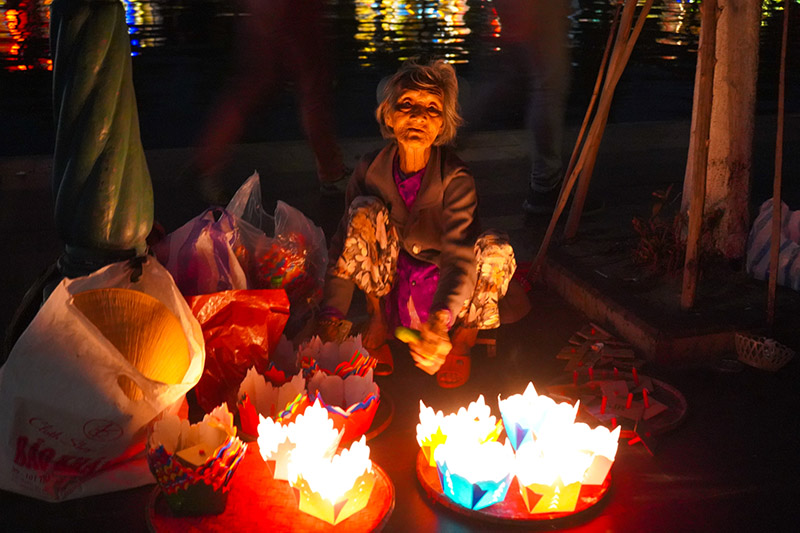
Pic by Jessica from Uprooted Traveler
Old Town Hoi An, a sleepy beach town located on the coast of central Vietnam, is a stellar example of a well-preserved Asian trading port from the 15th to 19thcenturies. This bustling city center, with traditional buildings and monuments reflecting Japanese, Chinese, and European influences, is built around a series of canals and bridges, and its famous yellow-walled buildings are tightly arranged in perfect rows, broken only by narrow pedestrian walkways.
From the lanterns strung everywhere to the dizzying maze of alleyways to its bustling market, Old Town Hoi An feels a bit like stepping back in time and, with its relatively small footprint, is the perfect place to wander around by foot and just get lost for several hours. Make sure to stroll across the Japanese Bridge and gaze out towards the Hoai River.
At night, you can watch the river come alive with floating colorful lanterns released from dozens of sampans (traditional Vietnamese canoes) along the river, which are meant to convey wishes of happiness and peace. In a setting like Hoi An, these wishes seem like they are destined to come true.
By Jessica from Uprooted Traveler
See Jessica’s amazing pic on Instagram at Uprooted Traveler
46. The Temple of Heaven in Beijing, China
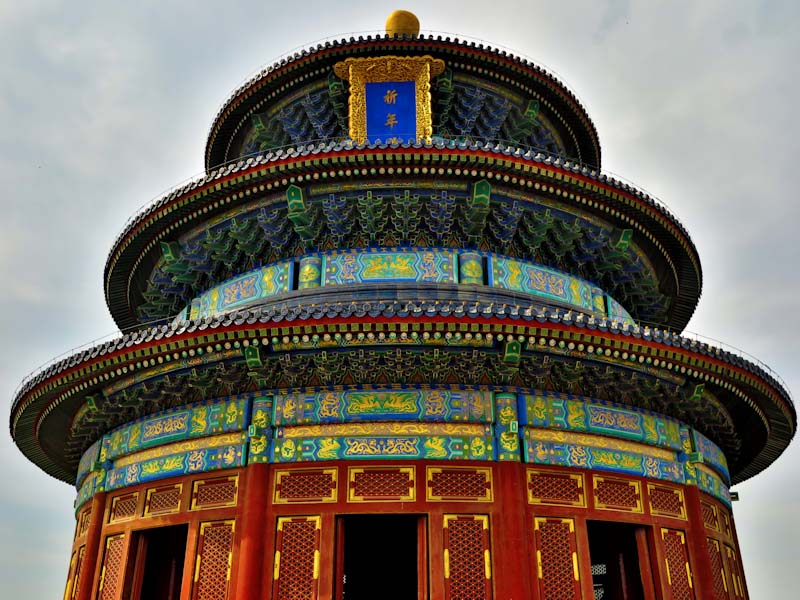
Pic by Sinead from Map made Memories
The Temple of Heaven in Beijing, China is not, as the name suggests, one temple. It is an enormous 15th-century religious temple complex covering an area larger than the Forbidden City. The different buildings found within the complex – such as the open, circular stone Mound Altar and the unassuming Imperial Vault Of Heaven – were constructed to symbolise the relationship between heaven and earth.
Our favourite building is the 38 metres tall, three-tiered Hall of Prayer for Good Harvests which was used only once a year by the Ming and Qing Emperors to pray for a good harvest. The Hall is bursting with colour and intricate designs and is lavishly decorated both inside and out. It is a stunning piece of architectural art.
Try to allocate enough time in your visit to explore part of the 660-acre park surrounding the complex and enjoy watching the locals playing competitive games of cards or chess.
By Sinead from Map made Memories
Follow Sinead on Facebook at Map made Memories
47. The tomb of King Wanggon in Kaesong, North Korea

Pic by James from Where you’re Between
hough most commonly known for its proximity to the DMZ on the northern side of the Korean border, Kaesong was once the capital city of Korea for over 500 years before that title was switched to Seoul. Though badly damaged during the Korean War, it’s long history meant that Kaesong escaped the worst of the fighting.
As a result there are many historical treasures in and around Kaesong that date from the Koryo Dynasty era between the 10th and 14th centuries. Many of the tourist trips to the DMZ call in to Kaesong, including a selection of the twelve historic sites that form Kaesong’s entry on to the UNESCO World Heritage List.
Before we visited the DMZ we were taken to two of those sites, the tombs of King Kongmin and King Wanggon. Dating from the 14th century, the tomb of King Kongmin is perhaps the most special, located at the top of a short steep hill surrounded by thick forests amid beautifully manicured grounds.
The King’s grass-topped domed tomb is protected by statues of tigers and soldiers alongside the tomb of his wife.
Around a mile away is the solitary tomb of King Wanggon, who was buried here in the 10th century. King Wanggon’s tomb was badly damaged during the Japanese occupation of Korea and suffered from several decades of neglect before finally being restored. Today, the tomb is set in a beautifully peaceful area in front of a majestic traditional Korean gate.
By James from Where you’re Between
See James’s amazing pics on Instgram at Where you’re Between
48. Vigan City in Philippines

Pic by Noel from Travel Photo Discovery
There are not that many ancient UNESCO sites in the Philippines that sparkle and retain that historic perspective like Vigan City in the Ilolos region of Luzon island in the country.
A well-preserved Spanish Colonial city, most of the ancient architecture has been well preserved to certify this as a World Heritage site since 2015. Many of the ancient buildings have been restored and repurposed into hotels, living museums, restaurants and other tourist-worthy places to visit in this fantastic town that really exudes that colonial presence that is rare in the Philippines.
One of the most famous cobblestone streets to explore is Calle Crisologo with all these impressive old colonial buildings in colorful and architectural details lined with galleries, restaurants and shops.
The entire city is filled with many gems worth visiting including the lively and busy farmers markets in the center of the city where you can try some local foods, baked goods, fresh tropical fruits and even buy some inexpensive local souvenirs.
Check out my visit to Vigan City here for more images and inspiration to visiting this Unesco site in the Philippines.
By Noel from Travel Photo Discovery
Follow Noel on Facebook at Travel Photo Discovery
49. Borobudur Temple in Indonesia

Pic by Darlene of Point and Shoot Wanderlust
In the center of the island of Java in Indonesia, lies the world’s largest Buddhist monument. Borobudur, originating from the words Bara (temple) and Budhara (hill), was built around the 9th century using andesite stones from the quarry site near Progo River.
If you look at it straight on from afar, it resembles a pyramid with its bell-shaped stupa on top of three circular platforms and five square terraces at the base. But if you look at it from above, it resembles an intricate mandala. For centuries, the temple lies dormant, overgrown and hidden by nature and volcanic ash until 1975, when the restoration works began.
Nowadays, the most popular activity in Borobudur is witnessing the sunrise from the horizon as visitors are seated on one of the levels of the temple. The morning light slowly bathing the stupas and the seated buddhas inside of it. The bas reliefs intricately carved on the lower levels are also a sight to behold.
It’s one of the temples in Southeast Asia that I had long wished to see and seeing it finally in person, even with a crowd, was a memory worth reliving.
By Darlene from Point and Shoot + Wanderlust
See Darlene’s amazing pics on Instagram at Point and Shoot + Wanderlust
50. Potala Palace in Lhasa, Tibet

Pic by Annalisa from Travel Connect Experience
The Potala Palace is the most important sanctuary for the Tibetan Buddhist religion, and, together with the Jokhang Temple, one of the two UNESCO heritage sites in Lhasa. Lhasa is the capital of the Tibetan Autonomous region in China.
The first King of the unified Tibet built the palace in 637, on the hill that concealed the meditation cave of Bodhisattva Chenrezig. In the 17th century, the Potala Palace became the seat of the fifth Dalai Lama and his successors, until Tibet fell to China in the 1950’s.
The site is included in any tour of Lhasa, and the visit can take up to 4 hours, as you walk through what were the living and study rooms and many chapels containing mandalas, and tomb stupas of the former Dalai Lamas. From the Potala Palace, you can also enjoy spectacular views on the city.
Traveling to Lhasa to see the Potala Palace and other religious buildings mean that you need to plan your trip with due advance. Once you have obtained a tourist visa for China, connect with a Tibetan travel agency: that’s how you will get you the necessary permits to enter Lhasa and a guide to escort you through the city.
By Annalisa from Travel Connect Experience
See Annalisa’s amazing pic on Instagram at Travel Connect Experience
51. Lumbini, the birthplace of Buddha in Nepal

Pic by Yana from Aware Impact
Lumbini is a Buddhist pilgrimage site. This place doesn’t see many foreign tourists. Mainly pilgrims visit here as the bus ride from Kathmandu takes approximately 10 hours.
According to the legend, Buddha was born in Lumbini in the 7th century BC. Maya Devi temple was built in the place where his mother gave birth. A gorgeous garden surrounds the temple. Buddhist monks gather under the Bodhi tree to chant the mantras every day. Talking a stroll in the garden, enjoying the chantings and the beauty of the flowers is a must.
Lumbini has a number of new monasteries and temples founded by Buddhist organizations from around the world. Each monastery reflects the nation’s architecture and view of Buddhism.
The Lumbini park is spread out and spans approximately 5 km long and 1,5 km wide. One of the best ways to get around is to hire a tuk-tuk for a day of sightseeing. You can also rent a bike in your hotel and explore the area by yourself as we did. This was one of the best experiences, cycling through the fields behind the monasteries at sunset.
One day is enough to explore all the temples and the monasteries since there’s not much else to do in this town. A tip for you – it’s best to avoid traveling to Lumbini in April-June since they’re the hottest months in Nepal.
By Yana from Aware Impact.
Follow Yana on Instagram at Aware Impact
I’ve just added so many of these must-visit UNESCO World Heritage Sites from Asia to my bucketlist. What about you? How many of these 50 plus sites have you visited? And how many are on your historical, architectural and cultural WHS bucketlist?
Other Posts to Read
- UNESCO site Machu Picchu
- Colosseum Facts
- Nahargarh Fort in Jaipur
- Karmel Mayerling and Prince Rudolf
- Historic Krupa Monastery



Wow that’s a super list ☺ nice reading details. packing my bags to start my journeys….